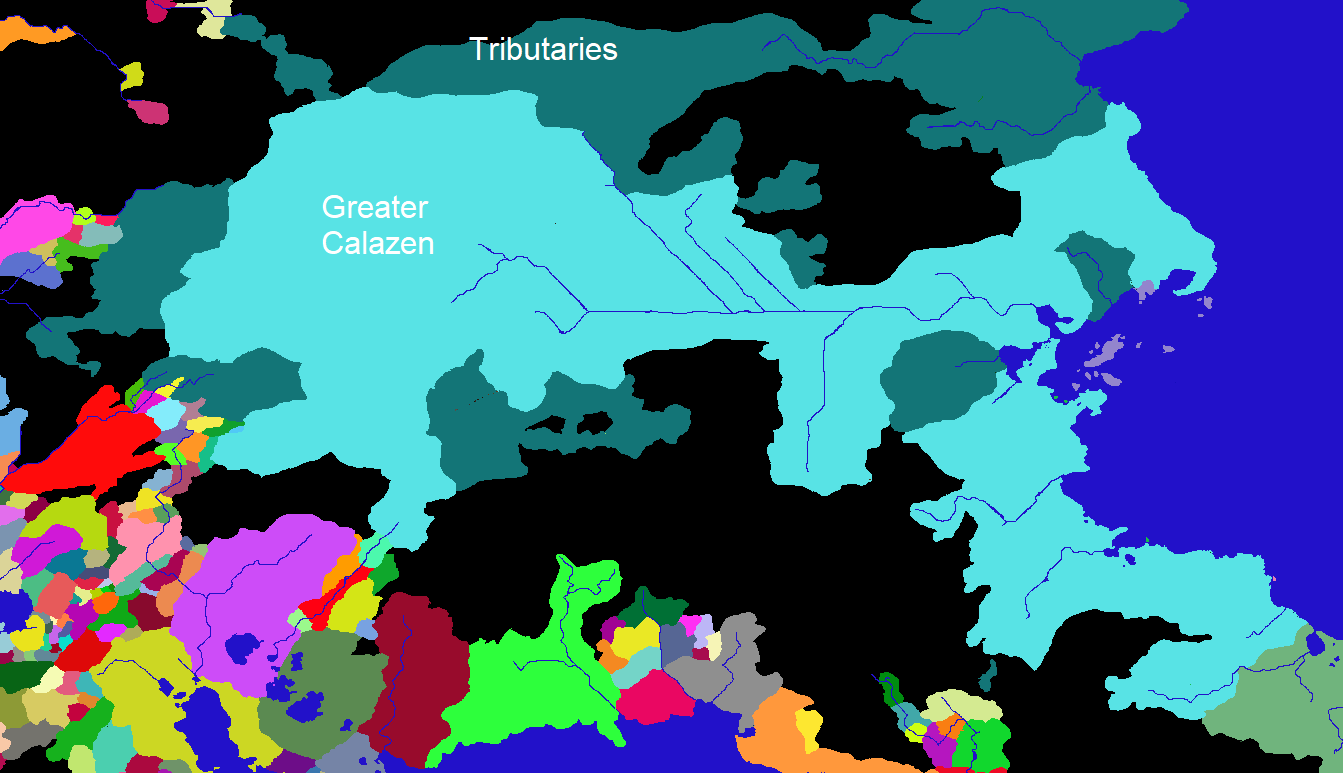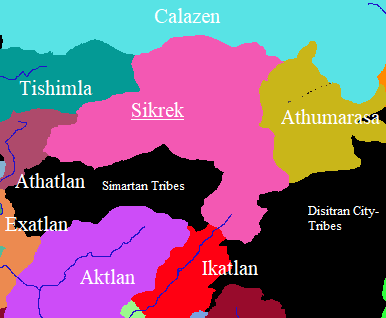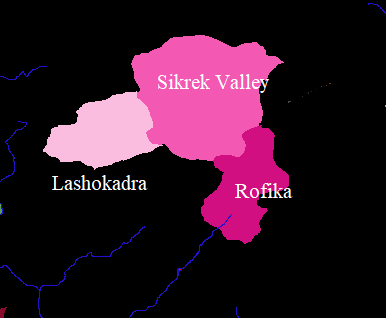Kingdom of Sikrek
Sikrek is the kingdom between worlds. Based out of a massive valley in the middle of the Adira Mountains, Sikrek is the stop between Inahng and Suneka, not quite Adiran and not quite anything else. Sikrek has always done things their own way, though they've been happy to take pieces of other land's institutions. They are the gatekeepers, after all: they have always seen themselves as the doorway between worlds, mystical and political.
In the last century, Sikrek has fallen to outside invasion at the hands of Calazen and has been thoroughly infused with their culture and systems of power. Even now, a Calazan queen sits on Sikrek's throne. But even as the massive influx of Calazan influence has shaped Sikrek's leadership and a large number of Stildanian and Sunekan lowborns have intermingled in areas, Sikrek has mixed and adapted as always.
Structure
Sikrekan society is divided between four legal classes: Godblooded, Free, Faidra, and Bound.
- Godblooded families are those which can trace their lineage in some way to one of the ancient demigods of Inahng. While all Divine-blooded sorcerers can attain this status, not all do - this status requires a recognized family tree or pedigree of lineage, which can be expensive to obtain or fabricate
- Free families are simply that- they are free subjects of the monarch. Merchants, lower gentry, and the middle class occupy this tier
- The Faidra are unique to Sikrek. They are Bound, born into obligation, but not to any individual or family. They are instead bound to the state and to Sikrek itself. They are indentured to the realm, and therefore have special claims to government jobs as well as special obligations and restrictions. They are often employed as state merchants, warriors, and clerks. They have their own organizations and hierarchy, and cannot own property directly.
- Bound families are those who are born to serve. They are rarely slaves, but neither are they free. The best of this lot are the Client Families, essentially artisan or upper-serf families that act as vassals for a more important free or blooded family (or even a faidra clan). Below these are Serfs, groups tied to land or communities with limited rights. Below these are Indentured- debt-servants with limited rights that are in many ways treated as property. The difference between them and slaves begins to dissapear when debt is transferred from parents to children.
- The King or Queen rules Sikrek with near-absolute authority. They must be of the blood to qualify
- The Small Council are extremely important leaders of the royal court, and assist the monarch in running the country
- The Magisters manage the land and the bureaucrats. They are of the Blood, but they are not full nobles- the monarch grants them temporary leases over land to raise money for government operation. Underneath them are armies of clerks, military officers, lower-gentry, and Faidra leaders that do most of the actual work
Culture
Rituals of Simplicity
Food Culture
History
Early History
Days of Division
Trade Era and War Era
Modern Sikrek
Demography and Population
Military
Sikrek's military is composed of two main bodies: The Adiran Skirmishers and the Main Body soldiers. The Skirmishers are light infantry, sharpshooters, and berserkers trained in traditional Adiran warfare. They are excellent raiders, skilled climbers, and great at ambushes. Skirmishers are traditionally Faidran, preserving ancient forms of warfare (or reimaginings of ancient warfare).
The main body soldiers are heavy infantry. While heavy infantry is common for Adiran peoples, Sikrek is famous for its pikes and halberds (rather than hammers, swords, or picks). The emphasis on pikes pairs particularly well with Sikrek's other traditional specialty: bows and crossbows. The wars with Suneka have seen the adoption of musket-troops as well, though firearms are not produced in particularly large numbers and typically are paired with crossbows and composite warbows.
Backing up these "pike and shot" divisions are sorcerers and chemical specialists. The Adirans have a long history of alchemical meddling, and the use of liquid fire in war dates back many centuries. These flamethrower soldiers work to break up enemy infantry formations by launching streams of burning chemicals- though the actual mechanisms for these flamethrowers are themselves infamously dangerous and finnicky. There has also been a slow adoption of Sunekan-style field cannon as a kind of specialist backup.
Sikrekan combat typically revolves around skirmishers controlling the greater battlefield and raiding enemy supply lines, while heavy infantry and ranged specialists fortify chokepoints. If there are no chokepoints, it is a matter of slow-moving battle lines and defensive maneuvers. This is less effective in non-mountainous terrain, particularly against highly mobile enemies.
The prior Calazan monarchs have attempted to introduce cavalry to Sikrek's army, but a lack of plains or swamplands makes horses or Sudraco difficult to breed in large numbers.
Religion
The government is fairly strictly Nedira-led in Sikrek, but it allows for a number of religious groups to exist in contained congregations. These contained congregations are for the most part being assimilated, but some groups retain their separate identity. The government is also fairly hands-off in regulating local belief, so lots of ancient or foreign-influenced beliefs remain within Nediran communities on the ground level.
Prevalent along the main trade routes are the old Faidra monasteries, left over from the Great Wheel movement of the 1100s. These monasteries were forcibly converted to the now-defunct religion of Daripar and then again to Nedira in the 1500s, but certain philosophies have always remained. The Great Wheel movement was based around the cycle of life-attachment: the idea that while one's soul and identity goes to Paradise or Purgatory, that one's life energy re-enters the ecosystem and universe. The soul, as a transcendent reflection of life, is tied to that life energy- and so the soul can never know true peace, as the life it reflects is still growing, suffering, and dying. The Great Wheel movement taught one to rediscover the universal truth of the whole and to learn to master suffering, so that the soul might reconnect with the universe in the afterlife instead of decaying in anxious suffering.
This is all to say that the monks of the road, who operated waystations and helped govern trade routes.
Foreign Relations
Sikrek is a dynastic partner of Calazen - ruled by one of the same family and deeply intertwined with Calazen's government. As Calazen is far larger and richer than Sikrek, this is something of a vassal-esque position.
A map of the dynastic union states:
Outside of dynastic affairs, Sikrek has mostly focused on peaceful trade relationships with its surrounding states. The newest monarch has grown restless, though, and many worry that she will plunge the state into needless wars of conquest.
Agriculture & Industry
Mining and agriculture are the main trades of Sikrek, and both are in comparative abundance. The salt mines of the valley fringe are extremely productive, and the valley itself is covered in rice, buckwheat, and potato farms. Yak, sheep, llama, chickens, and goats are all extremely common livestock, and the hilly areas unsuitable for crops are covered in them.
Aside from food production, mines also produce stone, lead, tin, lapis lazuli, coal, and other important gems. Minerals are also processed into dyes. Lumber forests are also carefully curated and worked according to strict schedules to avoid depletion.
All of these industries viciously compete with one another for one vital shared resource: water access. With no major rivers or lakes, the center for Sikrek's economic expansion has been a series of reservoirs that gather the snowmelt that typically floods each spring. A massive irrigation and aqueduct network controlled by the government and Faidra then rations this between the farmers, miners, manufacturers, and towns. It is through control over this water management system that the monarchy rules the trades with an iron fist. It is also a careful needle to thread. The government has focused a great deal on expanding the water system in the last two centuries, and magisters have imported large amounts of cheap foreign labor (often indentured) to most cheaply fulfill these grandiose projects.
Managing this extra labor pool can be difficult- many of these workers are contracted through wealthy families rather than directly by the crown. Local laborers resent this cheap labor, poorly managed indentured communities are prone to rebellion, the Lunar Pantheon isn't very fond of the practice, and after a major project is complete they are often superfluous. To quickly dispose of unwanted cheap laborers, they are often rented to Akatlan. This has proven lucrative enough for some magisters to actually begin selling their own citizens to Akatlan by using "anti crime campaigns" with ludicrous fines to press criminals into servitude and eventual sale. While the government has sought to discourage this trade, it has been ineffectual.
Trade & Transport
The fiercely competitive industries of Sikrek organize themselves by guild- even farming communities often send representatives to farmer's associations. These cutthroat guilds have formed coalitions along industry lines, known as Cartels. The Sikrekan Cartels are quite powerful but also internally factitious and often focused more on internal intrigue than market control.
Private merchants and State merchant companies act as interfaces for the cartels to deal with. There is a fair amount of cross-pollination between private merchants and public companies. Even though the state merchants are forbidden from holding private property, they often associate with private merchant companies interconnected with the state companies to do commerce by proxy.
Thanks to the direct state control imposed on state merchants, the government is able to exercise great control over trade when it wants to.
Education
Education in Sikrek is messy to say the least. Families of the blood are expected to use traditional Calazan education through elite schools that teach the Four Pillars of Divine Tutelage: writing, rhetoric, administration, and magic. This traditional education is extremely conservative in its curriculum and still uses texts and language from over 1000 years ago.
Below the elite schools of the blood are two competing school systems: traditional Faidra monastic schools, which teach discipline, swordfighting or archery, math, etiquette, and writing, and the Calazan Imperial Schools, which teach more with clerkship in mind. The monastic schools tend to recruit conservative Faidra clans and rural free-folk, while the imperial schools cater more to large towns. As well as Faidra and Free Folk, successful client families can also receive patronage to send a bright child up to one of these schools.
Rather than simplify this system, the most recent monarch has only complicated things further. Her royal highness Shomka I, in her desire to train a more competent and technologically flexible officer corp, created the War Schools and War Colleges: a third branch of education aimed at Faidra, Freefolk, Client Familiy, and Divine Blooded children alike. This system is a heavily modified version of the Sunekan school system originally built in the early 1900s by Nediran refugees from Akatlan. This private Sunekan system grew quietly in the 1900s and was briefly suppressed in the 1970s- but where others saw sedition, Queen Shomka saw potential. She seized control of the school system in 1992 and restructured it to be more military oriented. While the lower schools for younger children remain classically Sunekan and are less popular, the War Colleges (which accept children from all four lower education systems) for graduate education are increasingly popular. As Shomka herself is known to go so far as to attend lectures and discussions there, many ambitious families see it as a path to the royal court. While many rightfully bemoan the horrible inefficiency of tacking on yet another school system (and an opulent pet project of the autocrat, no less), it has actually produced a more innovative and meritocratic officer corps.
"Bridge to Heaven and Earth"
Founding Date
1955
Type
Geopolitical, Kingdom
Demonym
Sikrekan
Government System
Monarchy, Absolute
Power Structure
Unitary state
Currency
Calazan Gold Dragons, Silver Shells, and Copper Eyes
Major Exports
Lumber, stone, tin, lead, salt
Major Imports
Kilusha, food, gunpowder, spices, silk
Official State Religion
Location
Neighboring Nations
Related Plots
Dynastic Union
Remove these ads. Join the Worldbuilders Guild






Comments